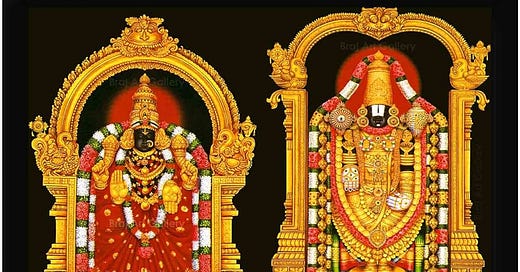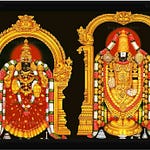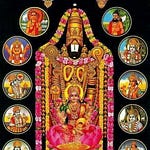On this most auspicious of days, Vijaya-daśamī, which also happens to be a Saturday in the month of Puraṭṭāsi that is particularly beloved of Lord Veṅkaṭeśvara, let us resume our previous series on the compositions of Śrī Prativādi-Bhayaṅkaram Aṇṇan Swāmī in praise of the Lord of the Seven Hills.
The Śrī Veṅkaṭeśa Stotram
Immediately following the recitation of the Śrī Veṅkaṭeśa Suprabhātam, the recitation of Aṇṇan Swāmī’s Śrī Veṅkaṭeśa Stotram commences. This is almost as well known as the Suprabhātam itself due to its playful and lilting meter (most distinctively, the meter known as Toṭaka) and its self-conscious sound effects.
Let us go through the verses one by one over the next several weeks.
Kamalā-kuca-cūcuka-kuṅkumato niyatâ-aruṇitâ-atula-nīla-tano! | kamalâ-āyata-locana! loka-pate! vijayī bhava Veṅkaṭa-śaila-pate! || (VSt 1) कमला-कुच-चूचुक-कुंकुमतो नियता-ऽरुणिता-ऽतुल-नील-तनो ! कमला-ऽऽयत-लोचन! लोक-पते ! विजयी भव वेंकट-शैल-पते ! ॥
O Lord whose incomparably blue-hued body is eternally streaked dawn-red from the vermillon upon the bosom of Your beloved Lotus-lady! O Lord whose lotus-petal-shaped eyes are permanently fixed upon Your beloved Lotus-lady! O Lord of all the worlds! May You be ever victorious, O Lord of Veṅkaṭa mountain!
The structure of the verse
Structurally, the verse is extremely simple: most of it is a series of vocatives (sambodhana) to Lord Śrīnivāsa, with just one short verbal phrase vijayī bhava (“be Thou victorious”). This phrase makes this verse quite appropriate for Vijaya-daśamī!
The first word
We have already seen in our discussion of the Veṅkaṭeśa Suprabhātam that Aṇṇan Swāmī begins each of his compositions with a reference to the Feminine. In this case, the first word (which occurs as the first element of a compound) is Kamalā, especially significant to Lord Śrīnivāsa because His consort is Padmāvatī, the Lady of the Lotus. We will see one more paradoxical reason for emphasizing this particular name for the Goddess just below.
The eternal unity of the Divine Couple
The first name for Lord Śrīnivāsa here takes up an entire line of the verse. It is, however, the second line of the verse. The first line of the verse provides the cause for the choice of name given to the Lord here. And what an amazing name it is!
The Lord’s name
The sacred body (tiru-mēni, in Tamil) of Lord Śrīnivāsa, of Lord Nārāyaṇa, and indeed of His various avatāras, is usually described as blue-black or black, and so on. This richly saturated dark color is meant to evoke in us a sense of awe, of the unfathomable depths of divinity which confront us in our encounters with the Lord. It is precisely this that is invoked by the second half of this first name: atula-nīla-tanu “an incomparably, incomprehensibly deep blue-hued body”.
But the first half of this name then modifies this dramatically: the Lord’s body, evocative of a lovely life-giving monsoon raincloud, or perhaps of the night sky, is then streaked with red—and not just any red, but the red of dawn (aruṇita). It is as if a lovely sun is rising and casting her light across the Lord’s lovely cloud/night body.
And what’s more, this is not an ephemeral phenomenon, the way dawn is in our natural experience—it is eternal, permanent (niyata). This word should bring to mind the related word niyati, which is used to mean “nature”. The hint then is that it is this eternal dawn on the body of the Lord which is in fact the true natural state of our universe. (Armed with this knowledge, we should then regard every opportunity to see the dawn sky as a chance to see the earthly shadow of this heavenly reality.)
The source of the eternal dawn
Where does this dawn come from, then? It is from the vermillion (kuṅkuma) that adorns the bosom of the Lady of the Lotus, Padmāvatī Tāyār. In other words, She is the sun whose eternal lustre illuminates the Lord’s broad chest.1
This is where the slightly paradoxical nature of the name Kamalā comes in here. After all, as we have now repeatedly seen in the Suprabhātam, the lotus blooms through its connection to the sun; by describing Mahālakṣmī as the Lotus-lady, we are then implicitly saying that Lord Śrīnivāsa’s face is the sun which makes Her blossom. But the logic of this verse, as well as other scriptural testimony, underscores the fact that She is in fact this source of light.2
The ultimate goal of this name is to demonstrate, through a most captivating image, the eternal aikyam (the eternal unity and the eternal union) of the Divine Couple. It is in Their eternal embrace that the cosmos takes shape.
The Lord, the Lotus-Lady, and us
The second name for the Lord here, kamalāyata-locana, can be read in two different ways, depending on how we interpret the first word of the compound:
Taking the first word to be the neuter form kamalam “lotus”, we obtain the interpretation that the Lord’s eyes are shaped like lotus petals. This is meant to highlight the eternal beauty of the Lord’s eyes, and hence to underscore our attraction to them, and through them to Him.
Taking the first word to be the feminine form kamalā “Lotus-lady, Padmāvatī”, we then obtain the interpretation that the Lord’s eyes are permanently fixed upon Her who is embracing Him. This interpretation then highlights the internal relationship between the Divine Couple.
Of course, the two interpretations are simultaneously validated through one of the unique attributes of Mahālakṣmī: Her puruṣakāratva or natural inclination to advocate on our behalf with the Lord. Sometimes this is phrased charmingly as Padmāvatī Tāyār distracting the Lord with Her own limitless beauty—thereby protecting us from His anger!
The domain of the Lord’s lordship
The third and fourth names highlight Lord Śrīnivāsa’s sovereignty and identity: being the Supreme Divinity for all of the cosmos (loka) while simultaneously also being physically fully and concretely located on the mountain of Tiru-veṅkaṭam.
The Lord’s full presence in His iconic forms (mūrtis) thus in no way diminishes the fullness of His presence or His divinity or His lordship over any other part of the universe.
Revisiting the verb
Thus having thought through the implications and interconnections of the different names of Lord Śrīnivāsa in this verse, we can now return to the verbal phrase vijayī bhava! This phrase can’t literally be wishing for the Lord to be victorious because, being the Ruler of the Cosmos, He cannot but be victorious! It is impossible for Him to lose. Instead, we must understand this in connection with the description of the first name: It is through His union with Padmāvatī Tāyār that Lord Śrīnivāsa is eternally victorious.
This then finally has a slightly cheeky, but profound, implication: if He is able to be victorious over all else because of Her, then that means He is not going to overrule Her! Consequently, we, Their children, can thus fearlessly rely on Her to protect us, even from His own anger and punishment.
It is this profound intra-Divine relationship of trust and love and mutual understanding that then creates the theological foundation for the Śrīvaiṣṇava doctrine of śaraṇāgati, taking refuge in the Divine Couple and trusting Them fully. And all of this emerges from just four names and a description of a (cosmic) dawn in this verse! What a remarkable feat by Aṇṇan Swāmī!
|| Śrī-Padmāvatī-nāyikā-sameta-Śrī-Śrīnivāsa-parabrahmaṇe namaḥ ||
I am obviously inspired by Swāmī Deśikan’s opening verse of the Śrī Stuti, where he describes Her as vakṣaḥ-pīṭhīṃ Madhu-vijayino bhūṣayantīṃ sva-kāntyā.
For instance, the Nārāyaṇa-sūkta describes the inner flame within our selves which is also identical with Mahālakṣmī as follows:
nīla-toyada-madhyasthā vidyul-lekhêva bhāsvarā
She is radiant, like a streak of lightning flashing through a blue-black raincloud.











Share this post